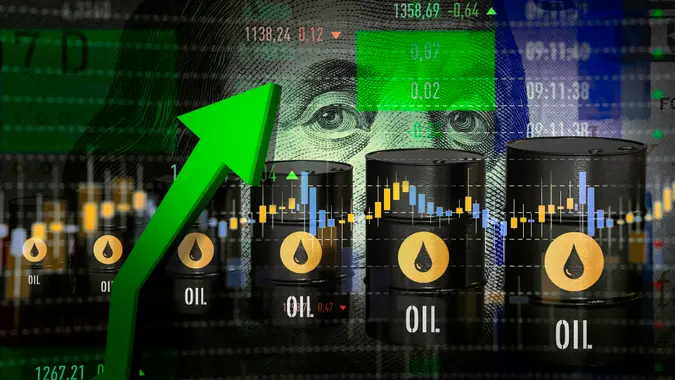11 Most Undervalued Stocks of October 2024

Commitment to Our Readers
GOBankingRates' editorial team is committed to bringing you unbiased reviews and information. We use data-driven methodologies to evaluate financial products and services - our reviews and ratings are not influenced by advertisers. You can read more about our editorial guidelines and our products and services review methodology.

20 Years
Helping You Live Richer

Reviewed
by Experts

Trusted by
Millions of Readers
Over the long run, value stocks have outperformed growth stocks. But for the past 15 years or so, growth stocks have been on a tear, trouncing value stocks with the brief exception of 2022, when interest rates rose sharply. This long period of underperformance could mean that value stocks are poised to once again assert their outperformance.
Indeed, these undervalued stocks had a slight edge in early 2024, despite all the headlines about “The Magnificent Seven” and the dominance of stocks like Nvidia. Will this trend continue? That’s something that you’ll have to discuss with your financial advisor. But holding a well-diversified portfolio that includes value stocks is always a good idea for long-term investors.
If you’re looking for some value stocks to add to your portfolio, here’s a list that can give you some ideas. Stocks have been selected based on a combination of factors, from their low price-earnings ratios to future growth prospects to analyst ratings.
11 Undervalued Stocks To Consider Right Now
It’s smart to look behind the numbers and get well-informed on the current state of any business you invest in. While the following companies passed a screen for high value, consider the list an introduction to some inexpensive stocks and not a recommendation to buy shares.
1. PayPal Holdings (PYPL)
- Market capitalization: $80.52 billion
- Next-year earnings growth estimate: 9.40%
- Trailing P/E: 19.10
- Dividend yield: N/A
- Industry: Financial services
- One-year target price: $81.45
PayPal Holdings is the very definition of an “unloved” stock, as its share price has cratered over the past three years. Shares of PYPL boomed during the pandemic, when it seemed as if no one would ever leave their house again and online financial services were the only way to go. However, since then, financial reality has set in, and growing competition and falling margins have hurt the stock.
Analysts are slowly coming around on the stock and see it returning to growth in the year ahead, with a potential one-year gain of around 3.5% — modest, to be sure, but the number of analysts rating the stock a “strong buy” has increased from six to 14 in the past month.
2. Adobe (ADBE)
- Market capitalization: $222.66 billion
- Next-year earnings growth estimate: 12.40%
- Trailing P/E: 42.92
- Dividend yield: N/A
- Industry: Software
- One-year target price: $625.88
A high-flying technology stock with a P/E over 40 may not seem like a “value,” but for Adobe supporters, it certainly is. The stock has returned over 85% over the past five years, but that’s after suffering a brutal drop of over 40% in 2022. Analysts find the company undervalued at current levels, as it has a wide economic moat and is expected to grow earnings by double digits annually over the next five fiscal years.
3. Entergy (ETR)
- Market capitalization: $27.99 billion
- Next-year earnings growth estimate: 7.20%
- Trailing P/E: 15.64
- Dividend yield: 3.40%
- Industry: Utilities
- One-year target price: $126.89
Utility stocks, like Entergy, are the poster child for value stocks, as they typically trade at low P/E multiples and have slow but steady growth profiles. However, in an environment in which growth stocks are trading at sky-high multiples and interest rates appear destined to fall, utility stocks have picked up some investor interest, with many analysts predicting future gains.
Entergy has a one-year price target slightly below current levels, but it also has a 3.40% dividend.
4. Honda Motor Co. (HMC)
- Market capitalization: $50.71 billion
- Next-year earnings growth estimate: 1.80%
- Trailing P/E: 6.56
- Dividend yield: 4.21%
- Industry: Auto manufacturers
- One-year target price: $40.50
Honda, like other automakers, had a tough ride during the pandemic era due to pandemic-related chip shortages and increasing material and labor costs. Although challenges remain, things might be starting to turn around for Honda. The company has beaten earnings estimates in each of its last five quarters, and analyst projections are bullish. In the meantime, the stock still trades at a very cheap multiple and pays a significant dividend.
5. Beazer Homes USA Inc. (BZH)
- Market capitalization: $1 billion
- Next-year earnings growth estimate: 16.70%
- Trailing P/E: 6.94
- Dividend yield: N/A
- Industry: Homebuilders
- One-year target price: $40.25
Headquartered in Atlanta, Beazer Homes USA builds throughout the South and in the western states of California, Arizona and Nevada. The company raises single-family and multifamily residential properties and has benefited from positive trends in the real estate sector.
6. Ternium S.A. (TX)
- Market Capitalization: $7.24 billion
- Next-year earnings growth estimate: 27.40%
- Trailing P/E: N/A
- Dividend yield: 9.02%
- Industry: Steel manufacturing
- One-year target price: $47.56
Ternium is a Luxembourg-based conglomerate with steel factory and mining subsidiaries in the United States and throughout Latin America. It sells and distributes steel beams, tubes, bars and rods, as well as roofing and decks, pre-engineered building components, pig iron and iron ore.
Steel and metal fabrication is a hard-fought and cyclical business, resulting in a relatively low valuation for Ternium and its competitors. The company is currently unprofitable, but analysts have a solid buy rating, with a 12-month price target about 29% above current levels.
On top of its fat dividend, the company could have a solid one-year future return. Value investors seeking to diversify their holdings outside of the U.S. may also find a steady Europe-based business of interest.
7. Federal Realty Investment Trust (FRT)
- Market capitalization: $9.34 billion
- Next-year earnings growth estimate: -6.10%
- Trailing P/E: 32.50
- Dividend yield: 3.94%
- Industry: Real estate
- One-year target price: $123.17
When it comes to real estate investment trusts, you can throw the price-earnings ratio out the door. This is because REITs generally have huge depreciation expenses that effectively lower their earnings and artificially boost their P/E ratios. This occurs even though depreciation is a non-cash expense that doesn’t take any money out of the company’s pockets. Thus, it’s more accurate to value REITs based on their price-to-funds from operations (FFO) ratio, which sat at 6.72 for the trailing 12 months that ended in June, according to GuruFocus.
FRT has over 60 years of experience in the real estate sector, focusing on retail environments and mixed-use neighborhoods in desirable markets. Analysts at Morningstar feel that real estate stocks are undervalued and that rental rate, net operating income growth and revenue will remain in an uptrend in 2024.
8. Albemarle (ALB)
- Market capitalization: $11.75 billion
- Next-year earnings growth estimate: 1,187.50%
- Trailing P/E: N/A
- Dividend yield: 1.72%
- Industry: Specialty chemicals
- One-year target price: $107.94
Albemarle is a specialty chemical company that’s growing by leaps and bounds, and yet it still pays investors a decent dividend. Analysts see staggering earnings growth for next year and a one-year price target more than 9% above current levels.
9. Dow Inc. (DOW)
- Market capitalization: $38.74 billion
- Next-year earnings growth estimate: 58.70%
- Trailing P/E: 34.14
- Dividend yield: 5.14%
- Industry: Specialty chemicals
- One-year target price: $57.16
Dow is a huge chemical conglomerate that’s one of the 30 components of the venerable Dow Jones Industrial Average. As a cyclical company, Dow futures can rise and fall dramatically in line with the global economy. But looking one year out, analysts see big growth for the company and a 9% stock price gain, on top of its quite hefty dividend yield.
10. Tyson Foods (TSN)
- Market capitalization: $20.81 billion
- Next-year earnings growth estimate: 26.10%
- Trailing P/E: N/A
- Dividend yield: 3.38%
- Industry: Food
- One-year target price: $62.17
The name “Tyson” is synonymous with chicken, but Tyson Foods also owns some of the most famous food brand names in the world, from Jimmy Dean and Hillshire Farm to Ball Park, Sara Lee and Gallo Salame. In addition to analysts projecting sizable earnings growth in the coming year, the stock pays a handsome dividend.
11. U.S. Bancorp (USB)
- Market capitalization: $69.48 billion
- Next-year earnings growth estimate: 9.50%
- Trailing P/E: 14.14
- Dividend yield: 4.55%
- Industry: Banking
- One-year target price: $50.61
U.S. Bancorp is the fifth-largest bank in America, with more than 70,000 employees, more than $28 billion in annual revenue, and more than 2,000 branches scattered across 26 states. With a P/E in the low teens, a double-digit growth rate and a dividend yield approaching 5%, U.S. Bancorp checks a lot of boxes in terms of being a value play for investors.
Risks and Challenges in Investing in Undervalued Stocks
The biggest risk to investing in a so-called “undervalued” stock is that the market has it right, and the stock is fairly valued.
For example, as you research undervalued stocks, your screeners might pull up a stock in the technology industry that is trading at a P/E of just 15x earnings, far below the average market multiple. This might lead you to believe that the stock is “undervalued,” but it may not tell the entire story. Perhaps the company is a consistent underperformer in terms of its earnings, or maybe it’s actually on the verge of bankruptcy. In that case, the stock might be overvalued, even though it appears to be a valuable stock on the surface.
Another risk is the tendency of truly undervalued stocks to remain that way for a considerable period. The stock market can often be an emotional place, and if a company develops a reputation as being staid or boring or has no visible catalysts for future growth, it may remain undervalued for months or even years. Other stocks may be “story stocks” that only trade on the hopes and dreams of individual investors.
If the story behind the stock never comes to fruition, the stock may never rise in value, trading sideways or even down as investors remain continually disappointed in its lack of execution.
Tips for Investing in Undervalued Stocks
Before you invest in an undervalued stock, you’ll have to completely understand what you’re getting into. Although value stocks can have a bit of a downside cushion, they can remain in downtrends or trade sideways for years, resulting in so-called “dead money.” To avoid this, take the following steps before you invest in a seemingly undervalued stock:
- Do your own financial research: Don’t rely on analyst suggestions — do the work of finding out the actual financial metrics of a company you want to invest in.
- Understand the trends of the company’s industry: Sometimes, market and industry trends can have a bigger influence on a company’s stock price than even its own current earnings trends.
- Learn why a company is undervalued: Some companies are undervalued for very good reasons; be sure a company you buy is poised for growth.
- Figure out the right time to invest: Value stocks can languish for years before making a move; try to hold off buying until a catalyst is on the horizon — or be prepared to simply collect dividends while you wait for capital appreciation.
- Protect yourself: Always have an exit strategy or a stop-loss for a stock so that it doesn’t tie up your money for too long or cost you too much if you make a bad decision.
- Look at the chart: Even fundamental investors often use charts to determine when a stock has favorable support or may be primed to move up or down.
How To Find Undervalued Stocks
There are many different ways to value a company. One of the most familiar to stock traders is the price-to-earnings ratio, also known as P/E. This is a stock’s price compared to the company’s earnings.
The stocks included in this list had P/E ratios near the bottom of the scale as of October 2024. Not coincidentally, they also had low price-to-sales ratios, which measure price against revenue, and low price-to-book ratios, which measure the stock’s price compared to the company’s net book value.
That makes these undervalued stocks interesting investments, but remember there’s often a solid reason stock isn’t cheap. The company may carry a lot of debt on its balance sheet; its industry may decline or be out of favor (coal, tobacco); or it may operate in troubled and unstable areas of the world.
Good To Know
If you’re not into researching individual companies, buy into an index fund. These funds track the performance of all stocks in an index such as the S&P 500 or the Russell 2000 index of small-capitalization stocks. If you’re looking for even more potential growth, consider one of the 12 best tech ETFs for 2024. Investing in an index fund ensures that you’ll never underperform the market — although you’ll also never outperform, as you might if you successfully pick individual stocks.
FAQ
Undervalued stocks can tempt investors to buy shares before they've done their homework. The answers to these frequently asked questions can help you avoid making the same mistake.- How do you find undervalued stocks?
- Several different metrics offer clues as to whether a stock is undervalued. A common one is a low price-to-earnings ratio compared to the ratios of companies in the same industry. A low price-to-sales ratio and price-to-book ratio also suggest a stock is undervalued. You can find these ratios for a particular stock by looking up the stock quote on a financial website such as Yahoo Finance or Investing.com.
- Do undervalued stocks always go up?
- All stocks are risky, and there's never a guarantee that undervalued shares will go up.
Thomas Streissguth and Daria Uhlig contributed to the reporting for this article.
Data is accurate as of Oct. 4, 2024, and is subject to change.
Our in-house research team and on-site financial experts work together to create content that’s accurate, impartial, and up to date. We fact-check every single statistic, quote and fact using trusted primary resources to make sure the information we provide is correct. You can learn more about GOBankingRates’ processes and standards in our editorial policy.
- DWS. 2024. "CIO View Macro - CIO Special 03/27/2024."
- Yahoo Finance. "3 No-Brainer Stocks to Buy."
- Morningstar. 2024. "33 Undervalued Stocks."
 Written by
Written by  Edited by
Edited by 




























